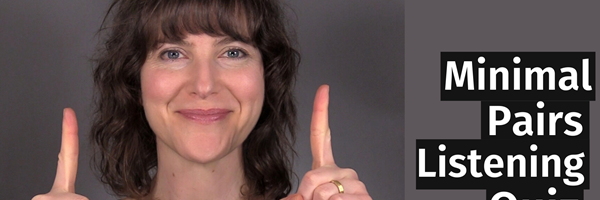(Video Transcript)
The EE in bead and IH in bid are two American English vowels that sound very similar, and most of my clients have difficulty with them. Some of my clients substitute the EE vowel for IH, so a word like live becomes leave, or some of them substitute the EH vowel for IH, so a word like bid becomes bed.
In this video, I’ll discuss how to make the EE in bead and the IH in bid vowels, and then you can test your skills with a listen and repeat quiz.
The EE /i/ Vowel
First, the EE vowel. EE. You probably have this vowel in your native language. To make this vowel, the tongue tip is down and touching the back of the bottom teeth. The middle part of the tongue is arched up towards the roof of the mouth. The tongue is tense and spreads flat in the mouth. The lips spread out slightly. EE.
Listen to how I pronounce the EE vowel in the word see. See. The EE vowel is held out and the pitch of my voice goes down. See. It’s not see with a flat, clipped EE sound. It’s see, with an elongated EE sound that glides down in pitch. In American English, it is common to hold out the EE sound when it occurs at the end of a word and glide down in pitch. See.
The IH /ɪ/ Vowel
Now IH. IH. You may not have this vowel in your native language. IH. To make this vowel, the tongue is in almost the same position as it is for EE. The tongue tip can stay down, behind the back of the front teeth. The middle of the tongue is still arched up towards the roof of the mouth, but it’s not as high as it was for EE - it’s a bit lower. The jaw also drops just a bit for IH, and the lips relax. IH.
There is also less tension in the tongue, lips, and jaw for the IH vowel - and this is one of the main differences between EE and IH. EE is a tense vowel - there’s more tension in your tongue and other articulators when you say this vowel. And IH is a lax vowel - much less tension in the articulators when you say this vowel. The lips and tongue should relax, and the middle of the tongue drops just a bit. IH.
EE - tension. IH - relaxed. EE, IH. EE, IH. EE, IH.
If you can’t hear the difference between these two vowels, don’t panic! Watch this video over and over again, and take the listening quiz that will follow, every day for a week or two. You will get better at hearing the difference between EE and IH, and your ability to say EE and IH will improve.
Listening Quiz
Now the listening quiz. We’re going to use minimal pairs for this quiz. Minimal pairs are two words that differ by just one sound, so the words sit and seat are minimal pairs - those words differ by one sound only - the vowel. The words big and bit are also minimal pairs - those words differ by one sound only - the final consonant. Minimal pairs are a great way to practice difficult sounds.
You’ll see two words on the screen. I’ll say one of the words, and you decide which word I said. Repeat the word after I say it, so you can practice both listening and speaking. Imitate exactly what you hear.
leap, lip (Answer: lip)
rich, reach (Answer: reach)
still, steal (Answer: still)
feast, fist (Answer: fist)
fit, feet (Answer: feet)
slip, sleep (Answer: slip)
sin, scene (Answer: sin)
lick, leak (Answer: leak)
peel, pill (Answer: peel)
gin, gene (Answer: gin)
Thanks so much for watching! And I'd love to hear from you - contact me to learn how we can work together to perfect your American English pronunciation!



